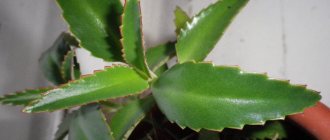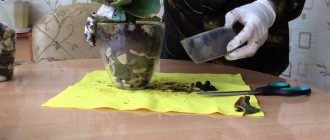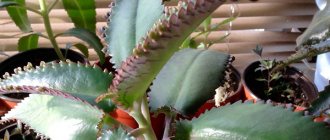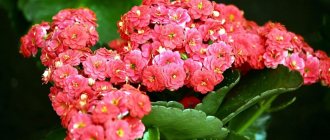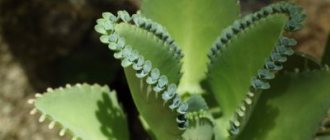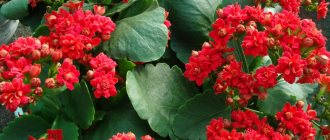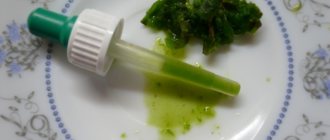- October 26, 2018
- Houseplants
- Darina Sakharova
Kalanchoe is an evergreen plant with fleshy and succulent leaves, which, according to most beginning gardeners, never blooms.
In fact, their statement on this matter is wrong. Some species of this plant can still bloom.
Therefore, if your flower still does not want to please you with its flowering, you should understand what is the matter, what is happening to the plant.
There are several reasons for this. Let's look at them in more detail.
Bad light
So, Kalanchoe does not bloom, what should you do? The plant does not like shaded places. In the shade it immediately begins to stretch out. He also does not like direct sunlight, despite the fact that the birthplace of this beautiful plant is the hottest continent on Earth - Africa. It prefers diffused light.
Therefore, this plant needs to choose a well-lit place. And you should remember: under no circumstances allow the sun to shine.
Let's look at a few more cases when Kalanchoe does not bloom at home.
Why a flower may not bloom, reasons
When does Kalanchoe bloom - how often at home
Improper care of the plant is the main reason for the lack of re-blooming of Kalanchoe. When purchasing, sellers often claim that the flower is undemanding - you just need to water it from time to time. But despite the fact that this flower is considered unpretentious, it requires special care to bloom.
Reasons for lack of flowering:
- Some Kalanchoes are annual hybrids. It is important to clarify this point when purchasing a plant.
- Incorrect lighting. The plant will be able to form buds only if there is a short daylight hours - no more than 10 hours. With a lack of light, the succulent can stretch and weaken.
- Incorrectly selected soil. The soil in the pot should be of neutral acidity, loose, and well breathable. In soil with an unsuitable composition, Kalanchoe does not grow or bloom.
- Excessive or insufficient watering. Succulents prefer dry, slightly moist soil.
- Failure to comply with temperature conditions.
- No rest period. After each flowering, the plant needs three to four weeks of rest. Otherwise, the buds simply will not have time to form.
- Too frequent or infrequent feeding. Excessive feeding increases the rate of foliage growth, but slows down the formation of buds.
- No pruning. From spring to late summer, it is necessary to pluck shoots from time to time. Otherwise, the bush may lose its original shape.
- Untimely transplant. You can change the place of residence of a succulent only after flowering, at the end of summer or beginning of autumn.
- Diseases or pests. You can identify parasites on a plant with the naked eye. Kalanchoe often cures most diseases on its own, but in some cases - for example, aphid infestation - it cannot do without help.
Kalanchoe is usually sold in such small pots
Watering
This is also one of the reasons why Kalanchoe does not bloom at home.
Like any other plant, it also needs water. It should be watered regularly and evenly. In this case, the plant is able to bloom after some time.
If you water it too infrequently, the plant may dry out. Well, if, on the contrary, there is too much, then the root system of the Kalanchoe will begin to rot. The plant may die.
Kalanchoe stretches upward and only lowers its leaves
Kalanchoe blooming: care at home and reasons why it does not bloom
When purchased, Kalanchoe looks like a beautiful bush with wavy leaves, densely covered with buds. But after a while, flowering stops, the plant begins to stretch upward, the green cover becomes smaller and gradually falls off.
Kalanchoe with elongated leaves and stem
Why does Kalanchoe stretch out and not bloom? There are only two reasons for the unpresentable appearance. The first is the lack of sleep period, which was mentioned above. After the end of flowering, Kalanchoe needs at least a month of respite, otherwise it simply will not have time to form new buds.
The second reason is lack of light. Like other succulents, Kalanchoes need a minimum of 10 hours of light. Due to lack of lighting, the stems and leaves begin to deform, become thin and fragile. As a result, foliage grows only at the top of the plant, which leads to damage to the weakened trunk.
Kalanchoe that has suffered from a lack of sunlight can be saved by installing additional lighting and pruning all elongated shoots. After pruning, it needs to be provided with a period of complete rest. It will take about a month to restore the dense crown of the plant.
Important! Kalanchoe should not be placed in direct sunlight. The leaves of the plant contain a large amount of water and can get sunburned.
Features of proper care and cultivation of Kalanchoe
Many novice flower growers ask the same question: “Why doesn’t Kalanchoe bloom and stretch out, what to do?”
In order for the Kalanchoe to please you with its flowering and not stretch upward, it is recommended to replant it approximately 2-3 times a year. It is best to plant it in a small pot; the plant will be much more comfortable in it.
Next, you need to prepare good drainage. You can either purchase soil in specialized stores or make it yourself. It should be noted that Kalanchoe does not really like acidic soils.
So, how can you make a special soil for Kalanchoe with your own hands at home? For this you will need: leaf soil, peat, river sand, and turf soil. Their ratio should be 2:1:1:4. If desired, you can also add humus (manure). But this is only if you want your plant to grow as quickly as possible. If you have a different goal regarding this plant, then it is better not to use humus.
Why doesn't Kalanchoe bloom?
There are several reasons for the lack of flowers in Kalanchoe:
- It is usually believed that Kalanchoe does not need special care, so the purchase is limited to replanting the plant in a new pot and minimal care for it. In the absence of sufficient lighting and nutritious soil, Kalanchoe is not able to form new inflorescences.
- Flowering Kalanchoes are most often sold in stores, and it may seem that this condition is permanent. In fact, forcing the plant is necessary to achieve this appearance.
- The young plant is usually grown in a pot suitable for transport only. Often the soil is saturated with minerals that remain effective for 2 months. Daylight hours for such a plant last up to 10 hours, so the bushes quickly begin to bud.
Temperature and lighting also play an important role in the flowering of Kalanchoe.
In some situations, if the Kalanchoe is stretched and does not bloom, it is necessary to check the correct lighting.
As for lighting, it must be there, because a plant cannot grow without light. In the autumn-winter period, the days become shorter, so it is necessary to create artificial light for Kalanchoe. To do this, you can use ordinary fluorescent lamps.
Temperature conditions. The air temperature in the room in the summer should be at least 16 degrees and no more than 25.
In the autumn-winter period, the optimal temperature for Kalanchoe is at least 10 degrees, ideally if the room temperature is 15 degrees.
In summer, it is recommended to plant Kalanchoe in the garden directly outside.
It should also be remembered here that if it is not so important to you how soon the Kalanchoe will bloom and whether it can bloom at all, then you can safely plant it directly in the ground. Well, if you really want your plant to bloom, then you need to plant the Kalanchoe in the ground along with a pot. So that the plant cannot grow in this way.
How to make Kalanchoe bloom?
As with any plant, the conditions for flowering are created by proper care:
- The room in which the indoor flower is located should be no warmer than + 25 degrees, and no colder than + 10. During the heating period, there is no need to place the Kalanchoe near radiators and electric heating devices.
Attention! If the air temperature rises above +26 degrees, you may not expect Kalanchoe to bloom.
- After flowering, all peduncles of Kalanchoe are cut off in anticipation of new shoots. When young branches begin to grow, it is necessary to pinch off the top two leaves.
- If the Kalanchoe grows tall, its top is completely cut off. New shoots should form in this place, and over time it is also necessary to pinch off a couple of leaves. Pinching gives the plant greater density.
- Pinching the shoots ends in November and if everything is done correctly, the first inflorescences should appear soon. At the initial stage, this may not be noticed, because the flower stalks will look like ordinary shoots; over time, it will be possible to discern the presence of buds.
- If, with the arrival of spring, the Kalanchoe still does not bloom, pinching the shoots must be resumed.
- It happens that in winter, Kalanchoe sheds its leaves; this problem is solved by replanting the plant with a complete replacement of the soil.
Important! After transplantation, the Kalanchoe may seem sluggish, but the situation will improve when young roots begin to appear, this may take up to 2 weeks. In a few more weeks, the first buds may appear.
Light level
Kalanchoe develops well in bright light, but bud formation occurs only if daylight hours are no more than 10 hours. To create such conditions, you need to come up with an artificial shelter in the form of a cardboard box or a paper cone; you can cover the Kalanchoe with a cloth. In daylight, the plant should be kept from 7 am to 17-19 pm.
Important! Kalanchoe can be placed on the south side of the windows; it is not afraid of sunlight.
When there is insufficient lighting, the Kalanchoe begins to stretch upward, and the leaves will fall off. If Kalanchoe is grown on northern windowsills, it will need additional lighting.
Proper plant replanting
It is necessary to replant the flower if it is clearly visible that the Kalanchoe is cramped in the old pot. A clay pot is best suited for such purposes; it allows air to pass through well. You can buy soil in specialized stores for succulent plants; if you take universal soil, it is better to mix it with sand.
It is also possible to prepare the earthen mixture yourself; for this you need to take:
- two parts of leaf humus;
- the same amount of coarse sand;
- two parts of turf land;
- part of the crushed coal;
- part of a brick crumb.
Lime can be added to this mixture to reduce the acidity.
Watering Kalanchoe
To properly care for a plant, it needs to be provided with proper watering. Due to the fact that the plant is a succulent, you should not water it when the soil first dries out. In winter, with the battery on, it is very difficult to see Kalanchoe blooming. Considering the natural growing conditions of the plant, in winter Kalanchoe is found in a cool environment and in dry soil.
Attention! Kalanchoe should be watered with settled water; under no circumstances should it be boiled.
To create the same conditions at home, after the top layer has dried, you need to wait a little less than a week and only then water the plant. With the arrival of spring, watering can be increased slightly and spraying can be added every 2 days. All these manipulations should provoke the active growth of buds from which flowers will appear.
Watering Kalanchoe with water
If the Kalanchoe still does not bloom and is stretched, then the problem may be related to water. Most likely, your plant needs it.
However, under no circumstances should the plant be flooded with water, nor should it be left without moisture for a long time. Otherwise, its roots will begin to rot or its leaves will fall off and dry out. And because of this, the plant will not only lose its attractiveness, but also die.
In summer, it is recommended to water Kalanchoe 2-3 times a week. In the autumn-winter period, once every two weeks will be enough. Under no circumstances should you pour tap water on it; you must let it settle. The water temperature should be room temperature.
Some species of Kalanchoe have smooth leaves. It is recommended to wipe such plants at least once a month with a damp cloth.
Kalanchoe with velvet leaves does not need such a procedure at all, otherwise its leaves will immediately darken.
Preparing for flowering
If the Kalanchoe was not transplanted in the fall, then the first half of March is perfect for this. You can read how to do this correctly here. Feeding begins in April and continues until the end of August (end of flowering). It should be done once a month using fertilizers for succulents and cacti. Complex fertilizers for flowering plants in lower concentrations than usual are also suitable.
Kalanchoe Blossfeld is fertilized twice a month.
If the plant's dormant period is spent correctly, it is provided with good lighting, regular watering as the soil dries out, fertilizing and correctly selected soil when replanting, then Kalanchoe will bloom at the right time and will be abundant and long-lasting.
Insects and other pests
What can interfere and why does the flowering Kalanchoe not bloom?
As a rule, Kalanchoe is very resistant to all kinds of insect attacks.
However, if there are too many pests plus improper care of Kalanchoe, for example, excess moisture, then the plant can no longer withstand all this. It stops blooming, its leaves begin to noticeably wither, the trunk and root system of the plant also weaken. Kalanchoe immediately becomes easily vulnerable and is thus very quickly attacked by various pests.
Such pests and diseases include: gray mold, aphids, mealybugs and many others.
In order to save the plant from them and restore Kalanchoe to health, it is necessary to comply with the parameters of its permissible humidity.
How to care for Kalanchoe after flowering
Proper care of Kalanchoe after flowering is the key to successful formation of buds in the future. To do this, you need to remove all the old flower stalks so that the plant does not waste energy on feeding them.
In addition, after the end of the flowering period, the crop should be pruned, removing all excess shoots. This will not only strengthen the plant, but will also allow young shoots to develop (Figure 5). During this period, you need to carefully observe the flower: in order for the plant to have the correct shape, young shoots should be periodically removed or pinched.
Figure 5. Plant care after flowering
Another important stage of care after flowering is to reduce watering. Moisture should be added to the soil only after the top layer of soil has dried, since stagnation of water at the roots will quickly cause root rot and death of the crop.
Agrotechnical features of growth and flowering of Kalanchoe
If this plant is satisfied with everything: favorable conditions, good soil, a convenient pot, then Kalanchoe can bloom from two weeks to three months. True, some species of this plant can delight with their flowering for up to six months.
And if Kalanchoe doesn’t bloom, what should you do?
If the entire flowering period was very short, then re-blooming of Kalanchoe can be specially provoked.
Especially for this, as soon as new buds appear, any fertilizing with any fertilizers is strictly prohibited until a certain point. It is also worth limiting watering the plant.
Well, after the plant begins to bloom, it is necessary to feed it with special mineral fertilizers. You can purchase them in a specialized store; such fertilizers are also suitable for cacti.
After your Kalanchoe has completely faded, it is recommended to put it in a dark room at night, namely from 17:00 to 07:00. It is recommended to do this specifically in order to reduce the plant’s daylight hours. Thanks to this, new young buds will begin to form in the Kalanchoe.
And after 2 months the plant will again be able to please you with its beauty. To speed up this process, you can also use various drugs.
Features of pruning for flowering
A flower bud forms at the end of each shoot.
To obtain a lush head of flowers on a bush, it is necessary to increase the number of such shoots. To do this, pinch the shoot, leaving 2-3 pairs of leaves on it.
Over time, new shoots will appear in the locations of the upper leaves. You need to do the same with them. By forming a lush, beautiful bush, the grower thereby prepares the plant for flowering.
Having lost unnecessary shoots, Kalanchoe concentrates its reserves of nutrients rather than spending them on forcing shoots.
Pruning Kalanchoe
Correct formation of the Kalanchoe bush itself
Another tip for caring for the plant when Kalanchoe does not bloom. What to do? It should be remembered that the appearance of the plant, as well as the ability to bloom, depend on the correct, systematic formation of the Kalanchoe bush.
To do this, you must follow the following rules:
1.After the Kalanchoe stops blooming, the old flower stalks must be removed.
2. In order for the bush of this plant to look attractive, it is necessary to promptly trim off excess shoots from the plant.
It is recommended to take care of the plant constantly in this way. Trim excess young shoots and remove old flower stalks. After the young shoots appear, you must first give them the opportunity to grow a little, and only then can they be cut off.
Literally after a couple of days, new shoots appear in place of the removed shoots. Now they need to be plucked off too.
Thus, thanks to timely pinching of the plant, the Kalanchoe begins to form correctly, its bush becomes dense and lush and will be able to bloom brightly and beautifully.
Features of Kalanchoe flowering at home
There are more than 200 varieties of culture in nature, and no more than 20 species live in houses. Tropical plants are accustomed to harsh environments to survive and do not require careful or complex care from their owners.
Kalanchoe does not bloom
Fleshy foliage has the ability to accumulate moisture, which allows the plant to go without water for a long time. But the formation of buds directly depends on the maintenance standards.
In addition to its decorative appearance, the culture is characterized by medicinal properties, which are widely used not only in folk but also in official medicine. Tinctures created from it:
- accelerate wound healing,
- suppress inflammatory processes,
- stop bleeding.
Industrially extracted juice can be purchased at any pharmacy.
Important! Because of its medicinal properties, the culture was called the “tree of life” or “doctor plant.”
How many times a year does it bloom, periods of activity and dormancy?
The formation of buds begins in winter; the exact time depends on the subspecies of Kalanchoe. With the arrival of spring days and warmth, they fall off, increasing their life expectancy is achieved by specialized techniques.
Some varieties of the crop are late-flowering - the first buds appear in early spring and fall off by the end of September or beginning of October. After the completion of the phase, the plant enters a dormant period: it is necessary to restore strength.
Important! Without observing the required rest time, the succulent will not form buds. To create complete dormancy, the wilted parts of the plant are removed and the pot is moved to a place with reduced daylight hours. Watering is logically reduced, and fertilizing is suspended until the next growing season.
Blooming succulent
Basic mistakes in flower care
Lack of information about proper care often leads to Kalanchoe not blooming. If the succulent does not form flower stalks, looks weak and unhealthy, you need to carefully check the conditions of its maintenance.
Incorrect lighting
Why does gloxinia not bloom at home?
Kalanchoe requires different amounts of light depending on the period of the plant's life. During the period of activity, the pot with the plant can be placed on the eastern or western windowsill. Window sills on the south side are not suitable, as direct sunlight can not only burn the flower, but also slow down its growth. On days of increased solar activity, it is better to shade the window.
Important! During the dormant period, the daylight hours of plants are artificially shortened. To do this, you can cover it with a box or put it in a dark room.
You can determine whether there is enough lighting for Kalanchoe by looking at the leaves of the plant. With enough light they have a reddish outline. Pale and elongated leaves signal a lack of sun.
Unsuitable soil composition
The pot of Kalanchoe purchased in a store is very small, and the soil consists of a peat substrate. This soil is not suitable for further cultivation, so the plant must be replanted.
For replanting, you will need a larger pot (about a few centimeters) with drainage holes, drainage and neutral acid soil for succulents. You can buy it from the body or make it yourself. To do this, you need to mix leaf soil (50%), peat (25%) and sand (25%).
Kalanchoe transplantation process
Step-by-step process for replanting Kalanchoe:
- Place a thin layer of drainage in the pot (no more than 1/6 of the height of the pot).
- Disinfect new soil with boiling water.
- Carefully remove the Kalanchoe, shake off the roots (no need to rinse) and place in a new pot.
- Water moderately and put the plant in a dark place for several days.
Important! Kalanchoe needs to be replanted every few years, changing the pot to a larger one.
Improper watering
Succulents do not need a lot of watering. Water the plant only after the soil has completely dried. Excessive watering of a succulent leads to metabolic disorders, rotting of the root system and the formation of mold and fungi, and insufficient watering leads to loss of foliage. Kalanchoe affected by severe drought will take a very long time to recover.
After watering
The main difficulty is that it is very difficult to externally determine the overflow of a plant. Usually all symptoms appear after a very long time, since all negative processes occur in the root system. A plant that has suffered from excess moisture can still be saved. To do this, the plant is dried and transplanted into new soil. In this case, it is important to remove all rotten parts of the roots, and treat the cut areas with a disinfectant.
Signs of Kalanchoe overflow:
- the appearance of yellow spots;
- limp and pale leaves;
- non-drying soil.
The amount of water needed for irrigation depends on the plant's life stage and temperature conditions. During the rest period, Kalanchoe is almost not watered, the rest of the time - about 1-2 times a week.
Advice! On particularly hot days, the leaves of the flower can be moistened with a sprayer or a damp cloth, avoiding the accumulation of excess moisture.
Unsuitable room temperature
The optimal temperature in the house for Kalanchoe during the flowering period is from 18 to 29 degrees. Since this plant is native to the subtropics, it is not afraid of heat and dry air. It is important to protect the plant from drafts - do not place it near open windows or running air conditioners.
For Kalanchoe, higher temperatures are also acceptable, but cold temperatures below 10 degrees or frost can cause serious damage to the plant. A flower damaged by cold can be saved by cutting off the entire upper part of the plant.
Important! High air humidity can lead to the development of fungal diseases of Kalanchoe.
Excessive feeding
Another common mistake is overfeeding. Excessive use of fertilizers leads to increased growth of green mass and lack of inflorescences. It is recommended to feed the succulent no more than once every three weeks, and during flowering - every two weeks. In winter and the dormant period, fertilizing is completely excluded.
Variety of Kalanchoe
Liquid products designed specifically for succulents are used as fertilizer. They must contain substances such as nitrogen, phosphorus and potassium. Fertilizer is applied only by the root method. To avoid burns to the roots, the fertilizer is diluted in a large amount of water (much more than what is written in the instructions).
There are several ways to make fertilizer for Kalanchoe yourself:
- Dilute a teaspoon of granulated sugar in a liter of water.
- Dissolve a succinic acid tablet (sold at a pharmacy) in a liter of water.
- Make an infusion from egg shells - pour boiling water over a handful of dried shells and leave for five days.
A lack of fertilizing is just as harmful to the plant as its excess. When caring for a flower, it is important to stick to the middle. You can determine whether a succulent needs additional nutrients by its appearance. The main signs are deformed, darkened or yellowed leaves and stems, lack of flowering and death of the lower leaves.
